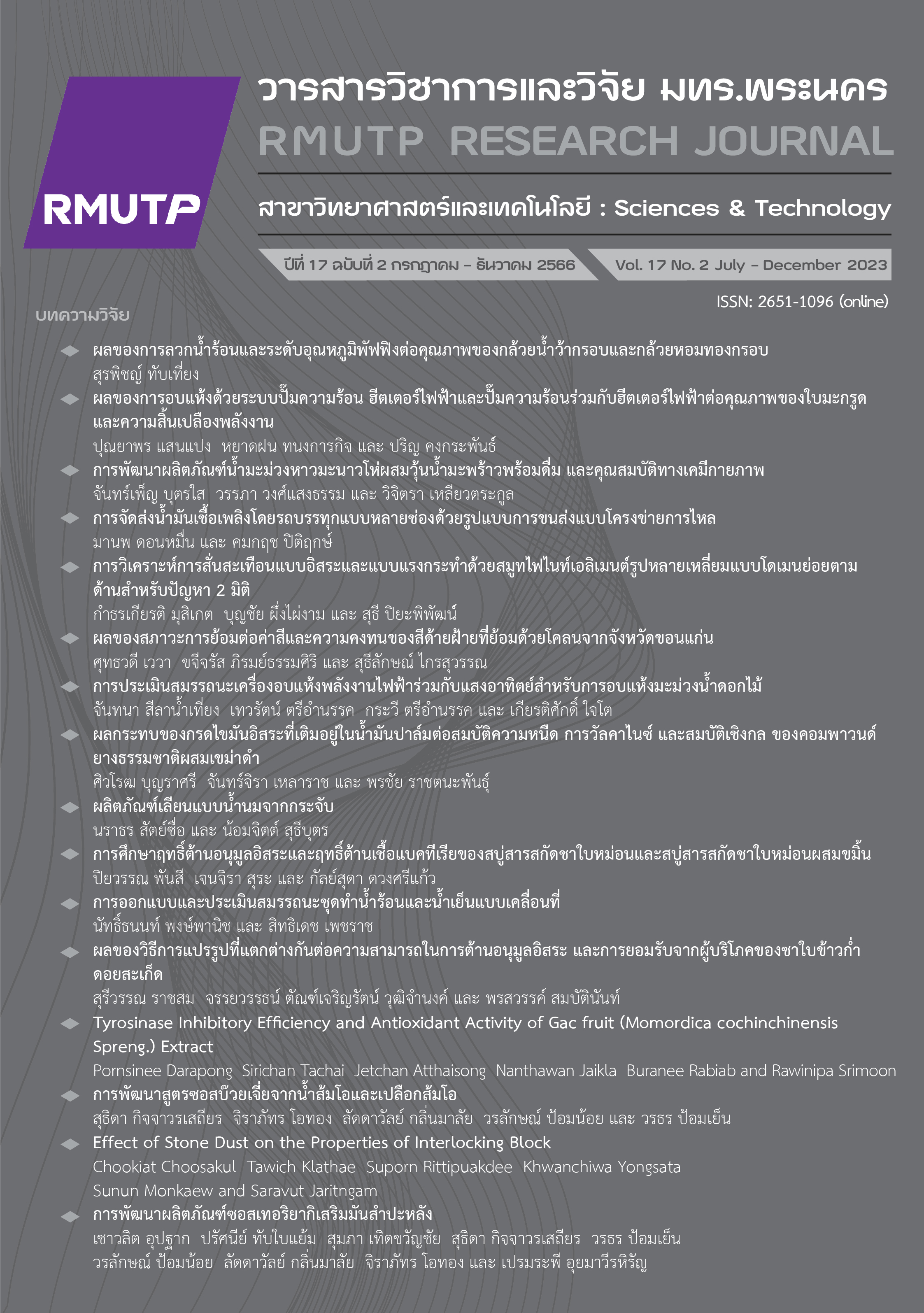Effect of Free fatty Acid Added in Palm Oil on Viscosity, Cure Characteristics and Mechanical Properties of Carbon Black Filled Natural Rubber Compounds
Main Article Content
Abstract
This research studied the carbon black filled natural rubber (NR) incorporated with palm oil contained free fatty acid (oleic acid added of 15% by palm oil weight) or stearic acid as activators were developed and characterized. The effects of the palm oil and stearic acid content (1–7 phr (part per hundred of rubber)) on the advanced natural rubber compounds’ properties were determined by measuring the Mooney viscosities, the scorch time, the curing time, 300% modulus, tensile strength, as well as elongation at break. It was found that the Mooney viscosities of the rubber compound with steric acid were lower than the compound with palm oil while the scorch time and the curing time were longer. As the stearic acid and palm oil in compound increased, elongation at break increased but 300% modulus and tensile strength of vulcanizes trended to decrease. The compound with 3 phr of palm oil displayed good cure and mechanical properties such as 8.15±0.3 minutes of cure time and 24.92±0.4 of tensile strength.
Article Details

This work is licensed under a Creative Commons Attribution-NonCommercial-NoDerivatives 4.0 International License.
ลิขสิทธ์ ของมหาวิทยาลัยเทคโนโลยีราชมงคลพระนครReferences
A. Y. Coran, “Vulcanization. Part VII. Kinetics of Sulfur Vulcanization of Natural Rubber in Presence of Delayed-Action Accelerators,” Rubber Chemistry and Technology, vol. 38, no. 1, pp. 1-14, 1965.
B. C. Barton and E. J. Hart, “Variables Controlling the Cross-Linking Reactions in Rubber,” Rubber Chemistry and Technology, vol. 26, no. 1, pp. 510-521, 1953.
H. Ismail and H. Anuar, “Palm oil fatty acid as an activator in carbon black filled natural rubber compounds: Dynamic properties, curing characteristics, reversion and fatigue studies,” Polymer Testing, vol. 19, no. 1, pp. 349-359, 2000.
Y. Singh, A. Sharma and A. Singla, “Non-edible vegetable oil–based feedstocks capable of bio-lubricant production for automotive sector applications—a review,” Environmental Science and Pollution Research, vol. 26, no. 15, pp. 14867-14882, 2019.
S. Fernandez, S. Kunchandy and S. Ghosh, “Linseed Oil Plasticizer Based Natural Rubber/Expandable Graphite Vulcanizates: Synthesis and Characterizations,” Journal of Environment Polymer Degradation, vol. 23, no. 4, pp. 526-533, 2015.
C. Siriwong, P. Khansawai, S. Boonchiangma, C. Sirisinha and P. Sae-Oui, “The influence of modified soybean oil as processing aids in tire application,” Polymer Bulletin, vol. 78, no. 7, pp. 3589-3606, 2021.
S. Boonrasri, P. Sae-Oui, A. Reungsang and P. Rachtanapun, “New Vegetable Oils with Different Fatty Acids on Natural Rubber Composite Properties,” Polymers, vol. 13, no. 7, pp. 1108, 2021.
A. Saetung, P. Patya and A. Rungvichaniwit, Using Vegetable Oil Replaced Aromatic Oil in Rubber Compounds, Full research report, The Thailand Research Fund (TRF) 2005.
B. Saad, C. W. Ling, M. S. Jab, B. P. Lim, A. S. M. Ali, W. T. Wai and M. I. Saleh, “Determination of free fatty acids in palm oil samples using non-aqueous flow injection titrimetric method,” Food Chemistry, vol. 102 no. 4, pp. 1407-1414, 2007.
I. M. Atadashi, M. K. Aroua, A. R . A. Aziz and N. M. N. Sulaiman, “Production of biodiesel using high free fatty acid feedstocks,” Renewable and Sustainable Energy Reviews,” vol. 16, no. 5, pp. 3275-3285, 2012.
A. K. Tiwari, A. Kumar, and H. Raheman, “Biodiesel production from jatropha oil (Jatropha curcas) with high free fatty acids: An optimized process,” Biomass and Bioenergy, vol. 31, no. 8, pp. 569-575, 2007.
X. Sun, and A. I. Isayev, “Cure Kinetics Study of Unfilled and Carbon Black Filled Synthetic Isoprene Rubber,” Rubber Chemistry and Technology, vol. 82, no. 2, pp. 149-169, 2009.
C. T. Loo “High temperature vulcanization of elastomers: 2. Network structures in conventional sulphenamide - sulphur natural rubber vulcanizates.” Polymer, vol. 15, no. 6, pp. 357-365, 1974.
T. R. Kukreja, R. C. Chauhan, S. Choe and P. P. Kundu, “Effect of the doses and nature of vegetable oil on carbon black/rubber interactions: Studies on castor oil and other vegetable oils,” Journal of Applied Polymer Science, vol. 87, no. 10, pp. 1574-1578, 2003.
G. Fard-Zolfaghari, A. Abbasian and M. Razzaghi-Kashani, “Insights into the compatibility of vegetable-based plasticizers on the performance of filled rubber vulcanizates,” Polymer Engineering and Science, vol. 61, no. 5, pp. 1379-1391, 2021.
R. Mohamed, N. Mohd Nurazzi and M. Huzaifah, “Effect of carbon black composition with sludge palm oil on the curing characteristic and mechanical properties of natural rubber/styrene butadiene rubber compound,”In IOP Conference Series: Materials Science and Engineering, IPO Publishing, Malaysia vol. 223, 2017, pp. 1-9.
S. H. Song, “The Effect of Palm Oil-Based Hybrid Oils as Green Multifunctional Oils on the Properties of Elastomer Composites,” Polymers (Basel), vol. 10, no. 9, pp. 1045, 2018.
J. Li and A. I. Isayev, “Recent development in application of bio-based oils in elastomers,” Rubber Chemistry and Technology, vol. 91, no. 4, pp. 719-728, 2018.
P. Intharapat, A. Kongnoo and P. Maiwat, “Bio-processing aids based on jatropha seed oil and its epoxidized derivatives in carbon black-reinforced natural rubber,” Journal of Vinyl and Additive Technology, vol. 26, no. 1, pp. 62-76, 2020.
N. Sovtic, K. S. Predrag, O. J. Bera, J. M. Pavlicevic, O. M. Govedarica and M. C. Jovicic, “A review of environmentally friendly rubber production using different vegetable oils,” Polymer Engineering and Science, vol. 60, no. 6, pp. 1097-1117, 2020.
C. K. Lee, J. G. Seo, H. J. Kim and S. H. Song, “Novel green composites from styrene butadiene rubber and palm oil derivatives for high performance tires,” Journal of Applied Polymer Science, vol. 136, no. 25, p. 47672, 2019.
C. Yan, A. D. Sarma, E. Moretto, J.-S. Thomann, P. Verge, D. Schmidt, F. Kayser and R. Dieden. “Semiquantitative Solid-State NMR Study of the Adsorption of Soybean Oils on Silica and Its Significance for Rubber Processing,” Langmuir, vol. 37, no. 34, pp. 10298-10307, 2021.


